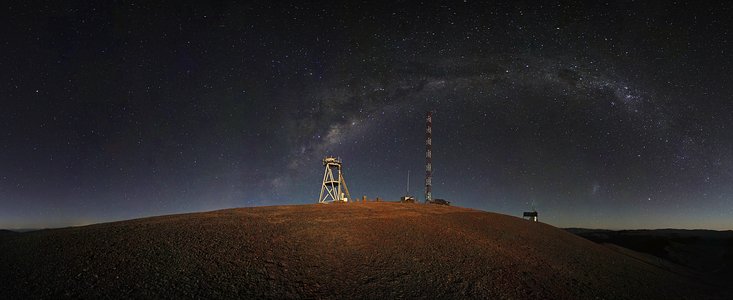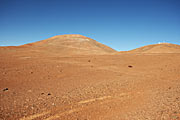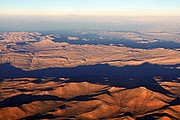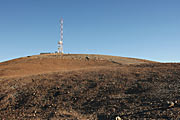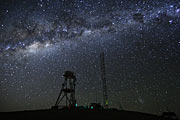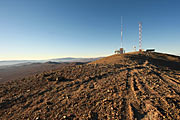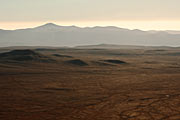Pressmeddelande
Platsen vald för E-ELT:
Världens största teleskop ska byggas vid Armazones i Chile
26 april 2010
Den 26 april 2010 valdes Cerro Armazones som plats för det planerade 42-meters European Extremely Large Telescope (E-ELT). Beslutet fattades av ESO:s råd. Berget Cerro Armazones, 3060 meter över havet, ligger i den centrala delen av Chiles Atacamaöken, 13 mil söder om staden Antofagasta och bara 20 kilometer från Cerro Paranal, berget som är hem till ESO:s VLT (Very Large Teleskop).
- Det här är en mycket viktig milstolpe. Det gör det möjligt för oss att fastställa baslinjen för designen i det här mycket ambitiösa projektet, som kommer att innebära en enorm framflyttning för den astronomiska kunskapen, säger Tim de Zeeuw som är generaldirektör för ESO. Jag vill tacka platsurvalsteamet för deras oerhört stora arbete under de senaste åren.
Att bygga ett europeiskt extremt stort teleskop för synligt och infrarött ljus (E-ELT) med en primärspegel på 42 meters diameter blir alltså nästa steget för ESO. E-ELT blir ”världens största öga mot himlen” och det enda teleskopet i sitt slag i världen. E-ELT kommer att angripa många av de mest pressande olösta frågorna inom astronomin. Dessutom kan det komma att göra revolution i vår syn på universum på ett liknande sätt som Galileis teleskop för 400 år sedan. Slutgiltigt grönt ljus för byggandet väntas i slutet av 2010, med driftstart planerad till 2018.
Beslutet om platsen för E-ELT fattades av ESO:s råd, som är organisationens högsta beslutande organ och som utgörs av representanter från ESO:s fjorton medlemsländer. Det är grundat på en omfattande meteorologisk undersökning som har tagit flera år att genomföra. Den största delen av de mätdata som samlats under platsurvalsundersökningen kommer att göras offentligt under 2010.
Flera faktorer behövde beaktas i processen som ledde till valet av platsen för teleskop. Till exempel är antalet klara nätter, mängden vattenånga och atmosfärens stabilitet (så kallad ”seeing”) alla mycket viktiga, men även andra parametrar togs med i beräkning, såsom kostnader för byggandet och drift, samt synergier med driften av andra viktiga anläggningar (VLT/VLTI, VISTA, VST, ALMA och SKA, med flera).
I mars 2010 fick ESO:s råd en preliminär rapport som innehöll de viktigaste slutsatserna som dragits av den rådgivande kommittén som utrett valet av platsen för E-ELT [1]. Rapporten bekräftade att samtliga platser som ingick i den slutgiltiga kortlistan (Armazones, Ventarrones, Tolonchar och Vizcachas i Chile, samt La Palma i Spanien) har mycket bra förhållanden för astronomiska observationer, var och en med egna styrkor. Den tekniska rapporten drog slutsatsen att Cerro Armazones nära Paranal framstod som den bästa platsen. Detta på grund av att den har en bra himmelskvalité enligt samtliga faktorer som tagits med i beräkning. Dessutom kan det drivas på ett integrerat sätt tillsammans med ESO:s Paranalobservatorium. Cerro Armazones och Paranal delar de samma utmärkta förhållanden för astronomiska observationer, med fler än 320 stjärnklara nätter om året.
Platsurvalskommitténs mycket tydliga rekommendationer samt alla andra relevanta aspekter, framför allt platsens vetenskapliga kvalitet, har nu tagits med i beaktning nu när ESO-rådet har godkänt valet av Cerro Armazones som platsen för E-ELT [2].
Tim de Zeeuw tillägger:
- När man kombinerar E-ELT:s omdanande vetenskapliga förmågor med det redan oerhört kraftfulla och integrerade observatoriet VLT garanterar detta långt in i framtiden Paranals plats som det mest avancerade observatorium i världen för synligt och infrarött ljus. Detta stärker än mer ESO:s position som den världsledande organisationen för markbaserad astronomi.
Inför valet av Cerro Armazones som den framtida platsen för E-ELT och för att underlätta och stödja projektet, har den chilenska regeringen kommit överens om att donera ett större landområde som angränsar till ESO:s egendomar vid Paranal och där Armazones ingår. Därmed säkras att platsen kan skönjas även framöver från alla negativa påverkningar, framför allt ljusföroreningar och gruvdrift.
Noter
[1] Den oberoende kommittén med ansvar för att välja platsen för E-ELT (Site Selection Advisory Committee, SSAC) har i detalj granskat ett flertal möjliga platser över hela världen. Liknande satsningar har även gjorts av motsvarande team för USA:s teleskop TMT (Thirty-Meter Telescope). För effektivitetens skull studerades inte platserna som ingick i TMT-teamets urval av möjliga platser (alla i Nord- och Sydamerika) av SSAC, då TMT-teamet delade sina data med SSAC. Två av platserna på kortlistan, bland dem Armazones, ingick i TMT-listan.
[2] ESO-rådets resolution lyder som följer:
Resolution of ESO Council on the Baseline Site for the E-ELT
Recognising
- the very clear recommendation from the Site Selection Advisory Committee that the E-ELT should be located on Cerro Armazones in Northern Chile
- the considerable scientific synergy that would result between the E-ELT and future facilities in the Southern Hemisphere, most notably ALMA and SKA
- the operational and scientific synergies with Paranal that would result
and expressing its warmest appreciation for
- the very generous offers from Spain and Chile to host the E-ELT
- the very considerable contributions to the quality and depth of the discussion on the siting of the E-ELT made by Chile and Spain in the course of developing their offers;
Council has concluded that the overriding driver for the decision on the location of the E-ELT should be the scientific quality of the site. The scientific qualities of Cerro Armazones and the positive impact that locating the E-ELT there will have on the future scientific leadership of ESO are sufficiently compelling to outweigh the very substantial offer made by Spain.
Council has therefore resolved to approve the recommendation of the Director General to adopt Cerro Armazones in Chile as the baseline site for the E-ELT.
Council noted that this decision is essential for the completion of the construction proposal for decision at a later date.
Mer information
ESO, Europeiska sydobservatoriet, är Europas främsta mellanstatliga organisation för astronomisk forskning och världens mest produktiva astronomiska observatorium. Det stöds av 14 länder: Belgien, Danmark, Finland, Frankrike, Italien, Nederländerna, Portugal, Schweiz, Spanien, Storbritannien, Sverige, Tjeckien, Tyskland och Österrike. ESO:s ambitiösa verksamhet rör design, konstruktion och drift av kraftfulla markbaserade forskningsanläggningar som gör det möjligt för astronomer att göra viktiga vetenskapliga upptäckter. ESO spelar dessutom en ledande roll i att främja och organisera samarbeten inom astronomisk forskning. ESO driver tre unika observationsplatser i Chile: La Silla, Paranal och Chajnantor. Vid Paranal driver ESO Very Large Telescope, världens mest avancerade observatorium för synligt ljus, och VISTA, det största kartläggningsteleskopet. ESO är den europeiska partnern i ALMA, ett revolutionerande astronomiskt teleskop och världens hittills största astronomiska projekt.
Länkar
- Mer info finns på engelska i E-ELT media kit
- Mer info i vår lista över vanliga frågor
- Om E-ELT på svenska
- Ta en virtuell tour av Cerro Armazones
- Bilder kring E-ELT finns på http://www.eso.org/public/images/?search=E-ELT
- Videor kring E-ELT finns på http://www.eso.org/public/videos/?search=E-ELT
Kontakter
Tim de Zeeuw
ESO Director General
Garching, Germany
Tel: +49 89 3200 6226
E-post: ikreutle@eso.org
Massimo Tarenghi
ESO Representative in Chile
Santiago, Chile
Tel: +56 2 463 3143
E-post: mtarengh@eso.org
Roberto Gilmozzi
E-ELT Principal Investigator
Garching, Germany
Tel: +49 89 3200 6667
E-post: rgilmozz@eso.org
Lars Lindberg Christensen
Head ESO education and Public Outreach Department
Garching, Germany
Tel: +49 89 3200 6761
Mobil: +49 173 38 72 621
E-post: lars@eso.org
Henri Boffin
ESO La Silla-Paranal/E-ELT Press Officer
Garching, Germany
Tel: +49 89 3200 6222
Mobil: +49 174 515 43 24
E-post: hboffin@eso.org
Johan Warell (Presskontakt för Sverige)
ESO:s nätverk för vetenskaplig kommunikation
Skurup, Sverige
Tel: +46-706-494731
E-post: eson-sweden@eso.org
Om pressmeddelandet
| Pressmeddelande nr: | eso1018sv |
| Namn: | Cerro Armazones |
| Typ: | Unspecified : Technology : Observatory |
| Facility: | Extremely Large Telescope |
Our use of Cookies
We use cookies that are essential for accessing our websites and using our services. We also use cookies to analyse, measure and improve our websites’ performance, to enable content sharing via social media and to display media content hosted on third-party platforms.
ESO Cookies Policy
The European Organisation for Astronomical Research in the Southern Hemisphere (ESO) is the pre-eminent intergovernmental science and technology organisation in astronomy. It carries out an ambitious programme focused on the design, construction and operation of powerful ground-based observing facilities for astronomy.
This Cookies Policy is intended to provide clarity by outlining the cookies used on the ESO public websites, their functions, the options you have for controlling them, and the ways you can contact us for additional details.
What are cookies?
Cookies are small pieces of data stored on your device by websites you visit. They serve various purposes, such as remembering login credentials and preferences and enhance your browsing experience.
Categories of cookies we use
Essential cookies (always active): These cookies are strictly necessary for the proper functioning of our website. Without these cookies, the website cannot operate correctly, and certain services, such as logging in or accessing secure areas, may not be available; because they are essential for the website’s operation, they cannot be disabled.
Functional Cookies: These cookies enhance your browsing experience by enabling additional features and personalization, such as remembering your preferences and settings. While not strictly necessary for the website to function, they improve usability and convenience; these cookies are only placed if you provide your consent.
Analytics cookies: These cookies collect information about how visitors interact with our website, such as which pages are visited most often and how users navigate the site. This data helps us improve website performance, optimize content, and enhance the user experience; these cookies are only placed if you provide your consent. We use the following analytics cookies.
Matomo Cookies:
This website uses Matomo (formerly Piwik), an open source software which enables the statistical analysis of website visits. Matomo uses cookies (text files) which are saved on your computer and which allow us to analyze how you use our website. The website user information generated by the cookies will only be saved on the servers of our IT Department. We use this information to analyze www.eso.org visits and to prepare reports on website activities. These data will not be disclosed to third parties.
On behalf of ESO, Matomo will use this information for the purpose of evaluating your use of the website, compiling reports on website activity and providing other services relating to website activity and internet usage.
Matomo cookies settings:
Additional Third-party cookies on ESO websites: some of our pages display content from external providers, e.g. YouTube.
Such third-party services are outside of ESO control and may, at any time, change their terms of service, use of cookies, etc.
YouTube: Some videos on the ESO website are embedded from ESO’s official YouTube channel. We have enabled YouTube’s privacy-enhanced mode, meaning that no cookies are set unless the user actively clicks on the video to play it. Additionally, in this mode, YouTube does not store any personally identifiable cookie data for embedded video playbacks. For more details, please refer to YouTube’s embedding videos information page.
Cookies can also be classified based on the following elements.
Regarding the domain, there are:
- First-party cookies, set by the website you are currently visiting. They are stored by the same domain that you are browsing and are used to enhance your experience on that site;
- Third-party cookies, set by a domain other than the one you are currently visiting.
As for their duration, cookies can be:
- Browser-session cookies, which are deleted when the user closes the browser;
- Stored cookies, which stay on the user's device for a predetermined period of time.
How to manage cookies
Cookie settings: You can modify your cookie choices for the ESO webpages at any time by clicking on the link Cookie settings at the bottom of any page.
In your browser: If you wish to delete cookies or instruct your browser to delete or block cookies by default, please visit the help pages of your browser:
Please be aware that if you delete or decline cookies, certain functionalities of our website may be not be available and your browsing experience may be affected.
You can set most browsers to prevent any cookies being placed on your device, but you may then have to manually adjust some preferences every time you visit a site/page. And some services and functionalities may not work properly at all (e.g. profile logging-in, shop check out).
Updates to the ESO Cookies Policy
The ESO Cookies Policy may be subject to future updates, which will be made available on this page.
Additional information
For any queries related to cookies, please contact: pdprATesoDOTorg.
As ESO public webpages are managed by our Department of Communication, your questions will be dealt with the support of the said Department.
